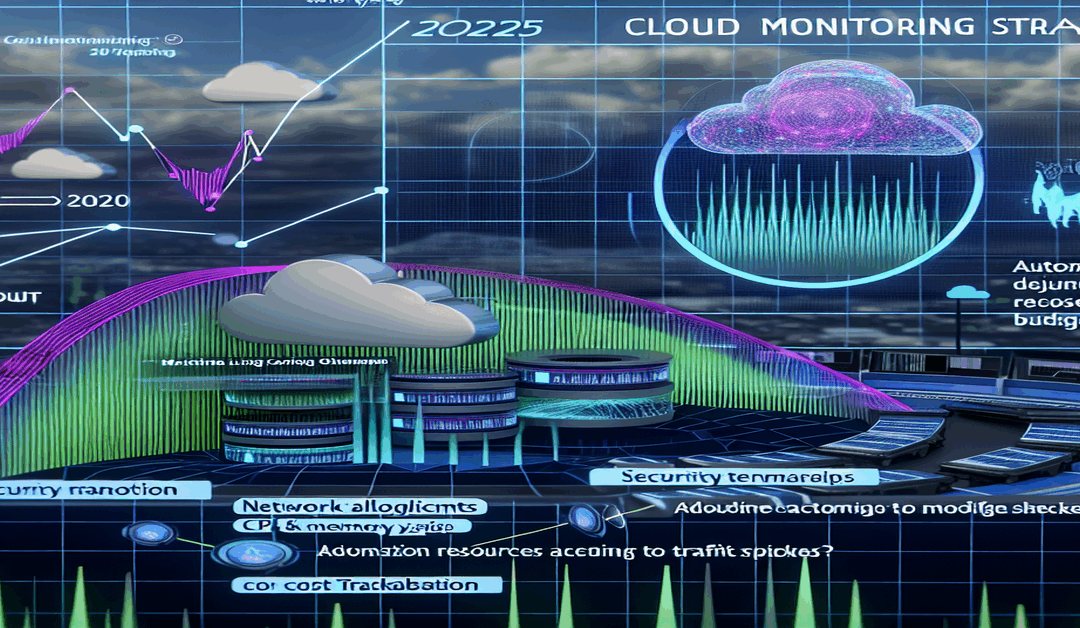Navigating the Cloud in 2025: Your Comprehensive Monitoring Strategy
As we hurtle towards 2025, the cloud computing landscape continues to evolve at a breakneck pace. With businesses increasingly relying on cloud infrastructure to power their operations, the need for effective monitoring strategies has never been more critical. In this blog post, we’ll dive into the essentials of cloud monitoring, explore the tactics and metrics you should focus on, and discuss how these insights can drive informed decision-making in the ever-changing world of cloud computing.
The Power of Cloud Monitoring
Picture this: you’re a developer working on a mission-critical application hosted in the cloud. Suddenly, you notice a spike in traffic, and your application’s response times start to suffer. Without proper monitoring in place, you’d be left scrambling to identify the root cause of the issue, potentially leading to costly downtime and frustrated users.
This is where cloud monitoring comes into play. By continuously collecting and analyzing data from various components of your cloud environment, such as applications, servers, networks, and databases, you gain invaluable insights into the health and performance of your system. These insights enable you to make informed decisions about when to scale resources, refactor code, or reduce costs, ensuring that your application remains responsive and reliable.
But the benefits of cloud monitoring extend beyond just developers. Cloud providers also rely on monitoring data to make strategic decisions about when to expand data centers or refresh hardware. By understanding the usage patterns and resource demands of their customers, providers can optimize their infrastructure to meet the ever-growing needs of businesses worldwide.
Metrics That Matter
To effectively monitor your cloud environment, you need to track a range of key metrics. These metrics provide a comprehensive view of your system’s performance and help you identify potential issues before they escalate into full-blown problems. Some of the most critical metrics to monitor include:
1. CPU and Memory Usage: Keeping an eye on the utilization of your compute resources is essential for ensuring optimal performance. If your CPU or memory usage consistently reaches high levels, it may be time to scale up your resources or optimize your application’s code.
2. Network Traffic: Monitoring network traffic helps you identify potential bottlenecks or security threats. By analyzing traffic patterns, you can detect anomalies and take proactive measures to protect your system from attacks.
3. Application Response Times: Slow response times can be a major source of frustration for users. By monitoring response times across different components of your application, you can pinpoint areas that need optimization and ensure a smooth user experience.
4. Error Rates: Keeping track of error rates is crucial for maintaining the stability and reliability of your application. By setting up alerts for when error rates exceed certain thresholds, you can quickly address issues before they impact your users.
The Power of Analytics and Automation
While tracking metrics is essential, the real power of cloud monitoring lies in the ability to derive actionable insights from the data. This is where advanced analytics and machine learning come into play. By leveraging these technologies, you can detect subtle anomalies and emerging issues that might otherwise go unnoticed.
Real-time dashboards and alerts can help your IT teams stay on top of your cloud environment’s health and performance. By visualizing key metrics and setting up automated alerts, you can ensure that any issues are addressed promptly, minimizing downtime and maximizing efficiency.
Automation also plays a vital role in modern cloud monitoring strategies. For example, you can set up auto-scaling policies that automatically adjust your resources based on traffic demands. This ensures that your application can handle sudden spikes in traffic without compromising performance or availability. Additionally, automated failover procedures can help maintain reliability during outages, minimizing the impact on your users.
Beyond Performance: Security and Cost Optimization
While performance monitoring is undoubtedly critical, a comprehensive cloud monitoring strategy must also encompass security and cost optimization. In today’s threat landscape, security monitoring has become more important than ever. By continuously monitoring your cloud environment for potential security breaches and compliance violations, you can proactively mitigate risks and protect your valuable data.
Cost monitoring is another crucial aspect of cloud management. Without proper oversight, cloud costs can quickly spiral out of control, eating into your budget and hindering your ability to invest in other areas of your business. By monitoring your cloud spending and identifying areas of inefficiency, you can optimize your costs and ensure that you’re getting the most value from your cloud investment.
Preparing for the Future
As we look ahead to 2025, it’s clear that organizations will need to make significant changes to their cloud strategies to stay competitive. One of the key areas of focus will be enhancing monitoring capabilities to drive operational efficiency and cost control.
By embracing advanced analytics, machine learning, and automation, businesses can gain a deeper understanding of their cloud environments and make data-driven decisions that optimize performance, security, and costs. This will require a shift in mindset, as well as an investment in the right tools and talent to support these initiatives.
Conclusion
In the fast-paced world of cloud computing, effective monitoring is no longer a nice-to-have—it’s a necessity. By implementing a comprehensive monitoring strategy that encompasses performance, security, and cost optimization, you can ensure that your cloud environment remains healthy, secure, and efficient.
As we move towards 2025, the organizations that prioritize monitoring and leverage data-driven insights will be best positioned to navigate the challenges and opportunities of the cloud. So, whether you’re a developer, an IT manager, or a business leader, now is the time to invest in your cloud monitoring capabilities and set yourself up for success in the years to come.
#CloudMonitoring #CloudStrategy #DataDrivenDecisions
Are you ready to take your cloud monitoring strategy to the next level? Share your thoughts and experiences in the comments below, and let’s start a conversation about how we can build a more resilient and efficient cloud future together.
-> Original article and inspiration provided by Aleksei Aleinikov
-> Connect with one of our AI Strategists today at ReviewAgent.ai

